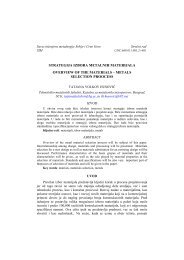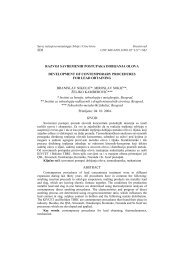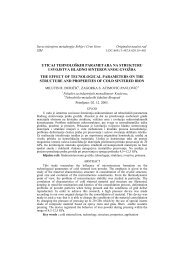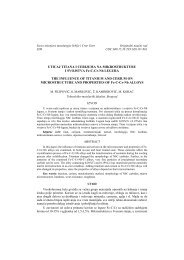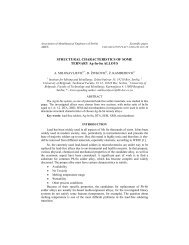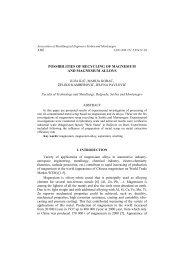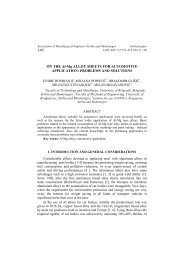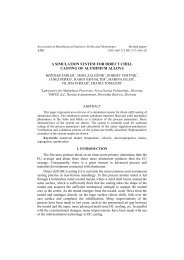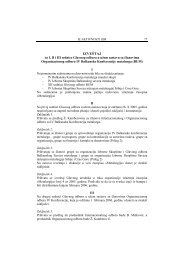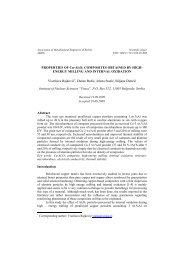THE INHIBITIVE EFFECT OF ETHANOLAMINE ON CORROSION ...
THE INHIBITIVE EFFECT OF ETHANOLAMINE ON CORROSION ...
THE INHIBITIVE EFFECT OF ETHANOLAMINE ON CORROSION ...
Create successful ePaper yourself
Turn your PDF publications into a flip-book with our unique Google optimized e-Paper software.
250 Metall. Mater. Eng. Vol 18 (4) 2012 p. 241-257<br />
Table 2. Corrosion parameters obtained from LSV measurements for aluminium in<br />
3 wt. % NaCl without and with inhibitor MEA after 30 min immersion at open circuit<br />
potential.<br />
C inh , mM R p , Ωcm 2 β a , V/dec β c , V/dec j corr 10 5 , Acm -2 IE, %<br />
Blank 2585 0.01409 -0.13923 1.178 -<br />
1 3226 0.0431 -0.1247 0.432 19.8<br />
3 3873 0.0135 -0.18612 0.14 33.3<br />
4 5079 0.01491 -0.1219 0.13 49.1<br />
5 9608 0.01915 -0.13931 0.0761 73.1<br />
7 5184 0.02308 -0.3683 0.1935 50.1<br />
8 3269 0.0181 -0.3958 0.2407 26.5<br />
It can be seen from Table 2 that the polarization resistance values increase up to<br />
5 mM and then decrease with higher concentrations of MEA. The cathodic reaction<br />
occurring at the aluminium-solution interface is hydrogen evolution. The results show<br />
that the cathodic slopes (β c ) are much greater than that expected for H 2 evolution<br />
according to Volmer-Tafel mechanism [25]. Such large cathodic Tafel slopes are not<br />
unexpected for aluminium, and have previously been reported for H 2 evolution reaction<br />
on aluminium electrodes covered probably with an oxide or an oxide-inhibitor complex<br />
[26]. The presence of inhibitor film influences the surface reduction process by creating<br />
a barrier to charge transfer through the formed film [27].<br />
The dependence of the corrosion current density on inhibitor concentration is<br />
shown in Fig. 8.<br />
The corrosion current density decreased with increase in concentration of<br />
inhibitor and reached the lowest value of approximately 8·10 -7 Acm -2 at a concentration<br />
of 5 mM of ethanolamine and then increased at higher concentrations of inhibitor. The<br />
observed increase in corrosion current density with increase in inhibitor concentration is<br />
probably due to the instability of inhibitor film and its desorption from the metal<br />
surface. The obtained results are in accordance with inhibition efficiency of<br />
ethanolamine (Fig. 5)




